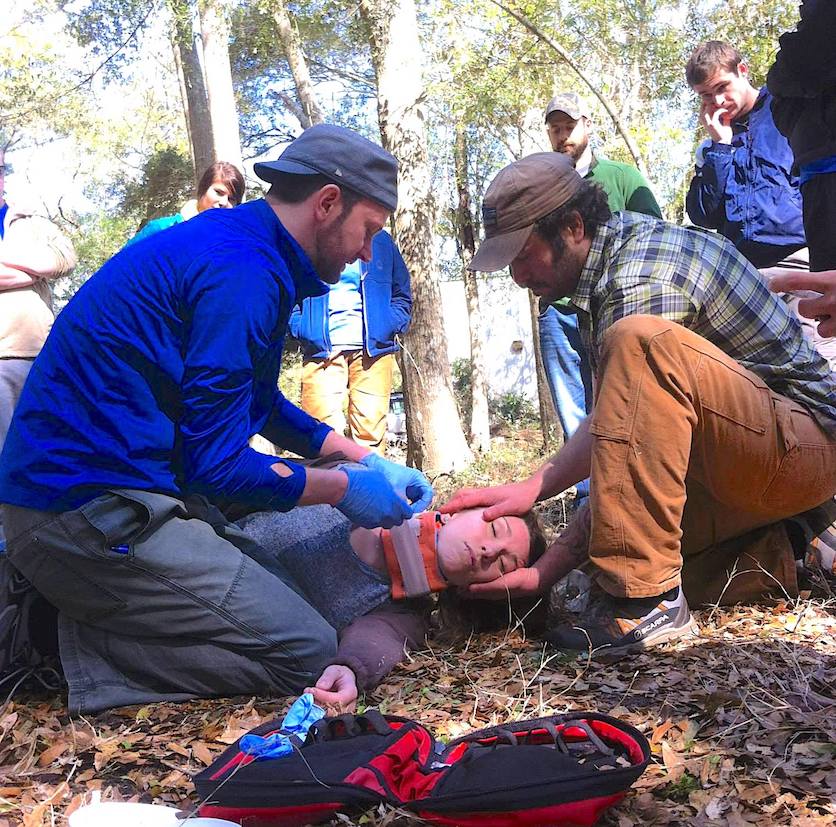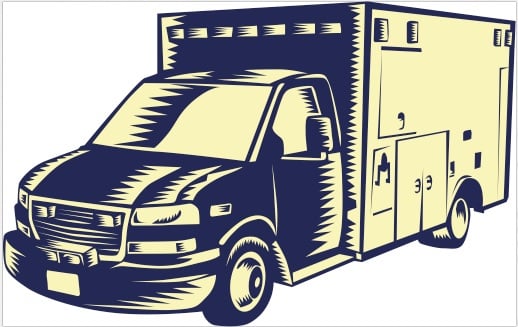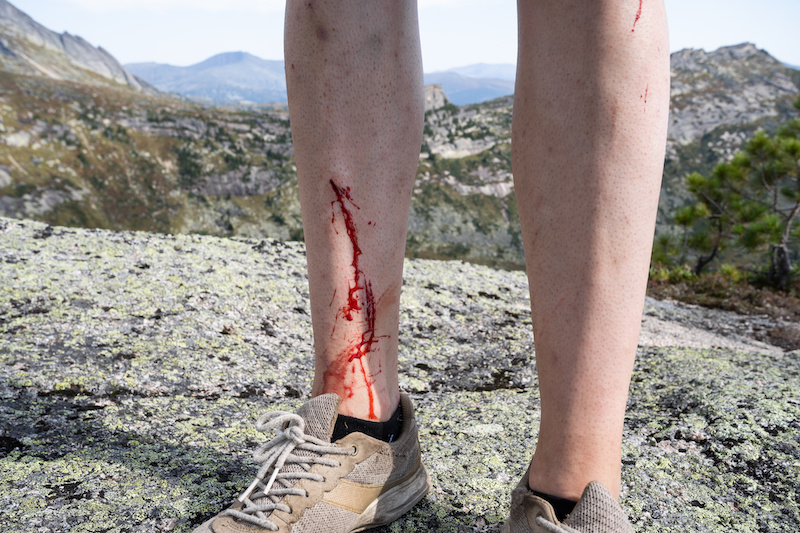New Thinking about How to Handle Spinal Injuries in Remote Wilderness Settings
Wilderness Medicine TrainingBest practices for evaluating and transporting patients with potential spinal fractures or spinal cord injuries is a hot topic in emergency medicine. And it’s no wonder. All of us who work in the adventure programming and emergency medical services field fervently want to avoid causing or worsening a potentially catastrophic injury to someone’s spinal cord.
As such, and for many decades, EMS officials dogmatically insisted that “immobilizing” patients with potential spine injuries was the best protection from further harm. Protocol demanded rigid backboards, cervical collars, head blocks, and yards of tape and straps to prevent someone who is injured from moving. However, new research suggests this is not only ineffective, but quite likely harmful.
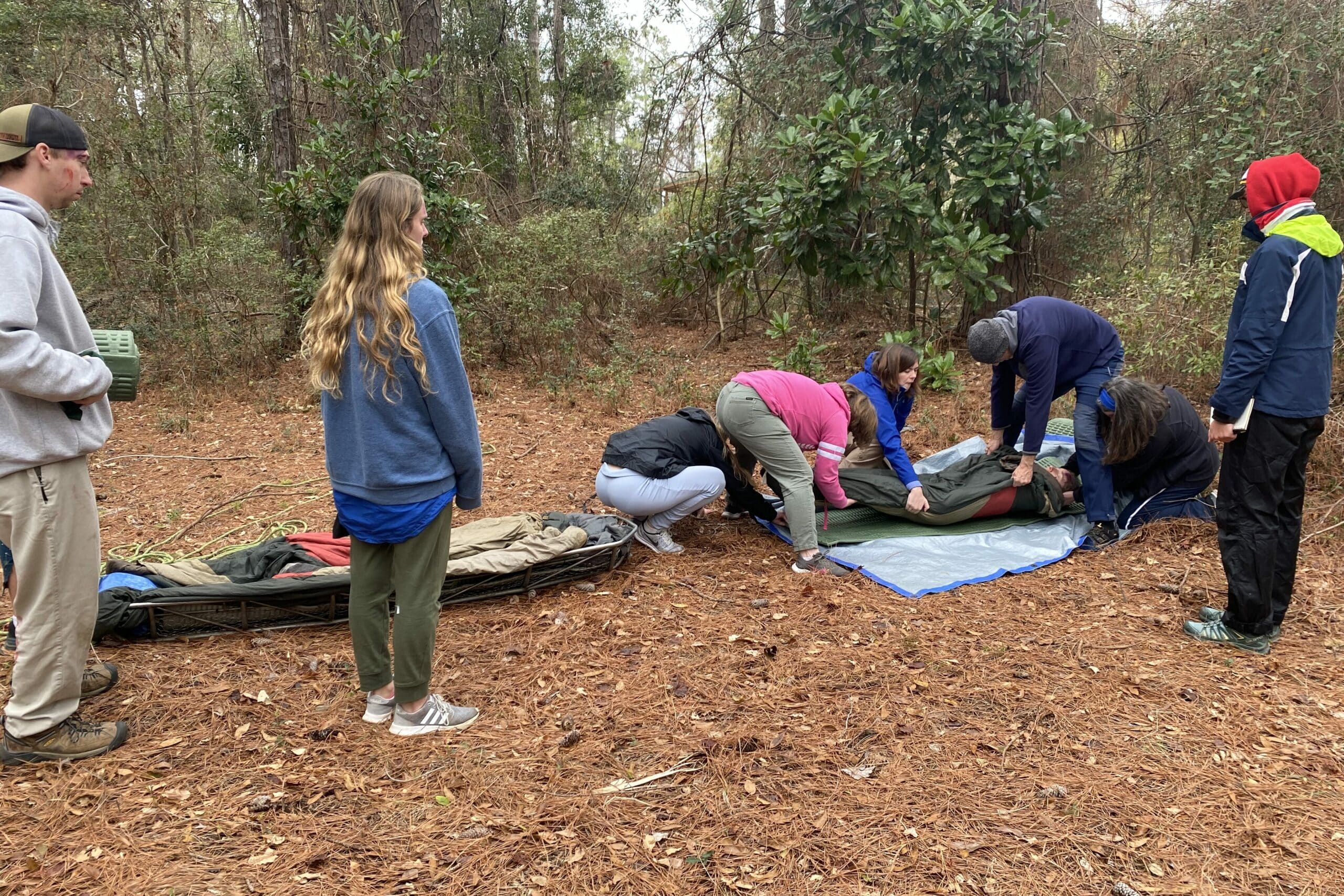
Immobilization Dismissed as the Tool of Choice for Patient Transport
Anyone suffering a spinal injury could have a spinal fracture. And that fracture could be unstable. So, if your client (i.e., patient in this case) moved even a little bit (like turning their head), that unstable spinal fracture could slide around and cause spinal cord injury. And that spinal cord injury could cause them to be paralyzed forever.
The Old School solution was to prevent them from moving on their own. Only let trained first responders (including outdoor educators, field instructors, and guides who are certified in wilderness medicine) lift/move the injured patient. Immobilize them to a rigid device — essentially a full-body splint — and get them out of the backcountry and to a hospital.
Upon what was this edict based? Essentially nothing. A few case reports that, on closer scrutiny, don’t indicate any (more…)
Concussion Recognition and Treatment in the Backcountry
Wilderness Medicine TrainingConcussion recognition and treatment has gotten a lot of attention over the last decade, mostly in the context of youth and professional sports such as tackle football and soccer. It’s even a topic for those who serve in our armed forces. However, confusion over its prevention, diagnosis, and treatment remains widespread.
In an interview with a reporter from the Chicago Sun Times, former National Football League quarterback Brett Favre, who was knocked out cold only once in his 20-year career, claimed that “probably 90 percent” of the tackles he endured left him with a concussion.
He’s most likely correct in that estimation. After all, the definition of “concussion” is broad: “A concussion is a brain injury, a disturbance in brain function induced by traumatic forces, either from a direct blow to the head or a transmitted force from a blow to the body.” It disrupts brain function at the cellular metabolic level but does not result in major structural damage. Conventional MRI or CT scanning will not show evidence of a concussion.
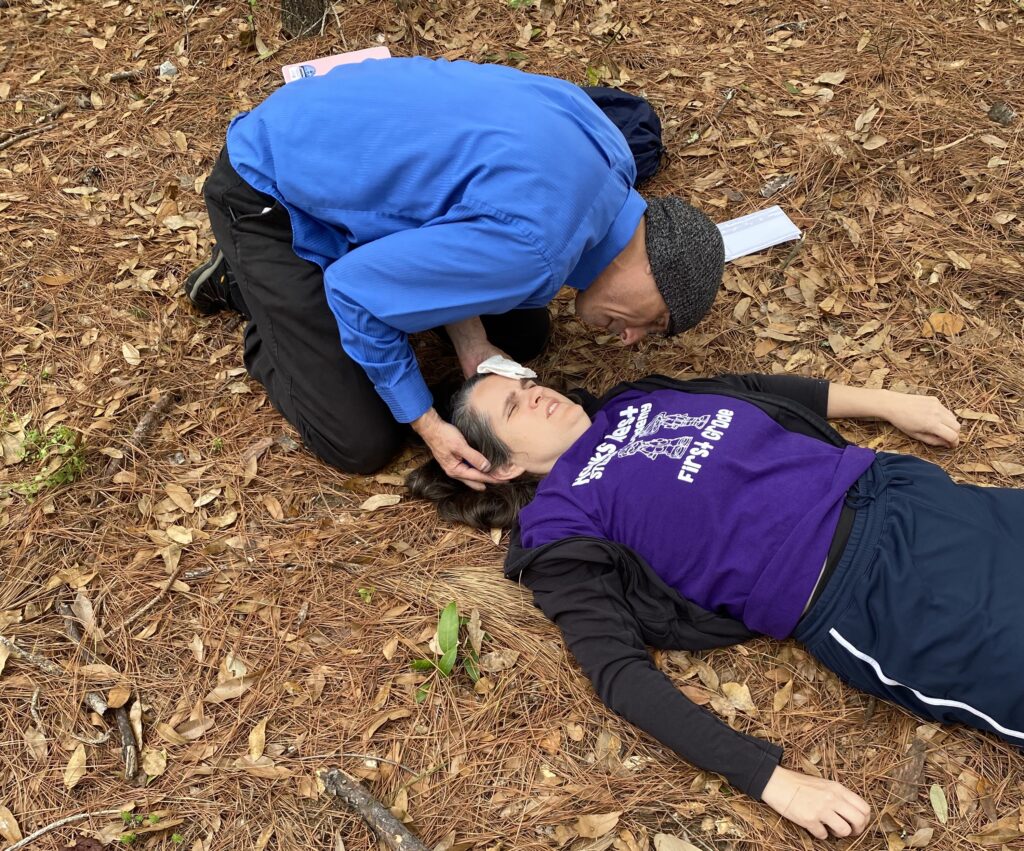
So, how do you know if you or someone else has suffered a concussion while in the backcountry? And, after having made that determination, what should be done? Having clear answers to these two questions is essential for successful recovery and to prevent long-term cognitive and psychological complications. This is true no matter where the concussion takes place, but especially in the backcountry where medical treatment from a full-time team is unavailable. (more…)
Avoiding Target Fixations and Incident Pits in the Backcountry
Risk Management“Look where you want to go!”
I have conveyed this message to wilderness course participants countless times, shouting, screaming, and using hand signals when necessary. Sometimes I’m yelling above the roar of a set of rapids or the sound of an adjacent waterfall.
“Look where you want to go!”
I emphatically issue the same advice while watching climbers rappelling down a cliff, or verbally guiding a student on a mountain bike through a sketchy section of trail. In each case, the point of my shouting is to get the students to stop looking at the obstacle.
“Look where you want to go” really translates as “Stop looking at the obstacle! Don’t fixate on the hazard!”
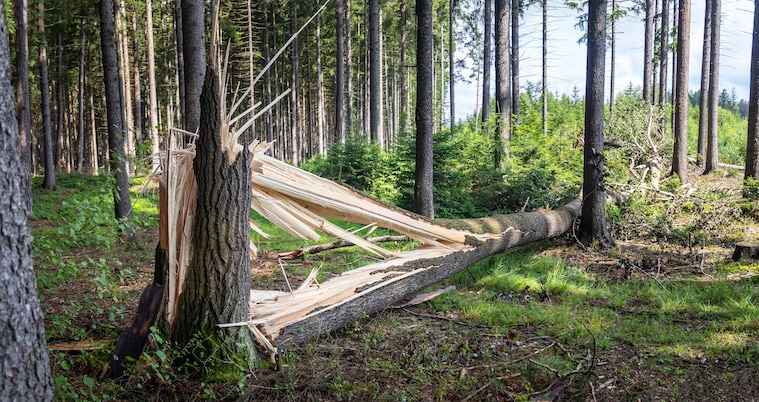
And it doesn’t matter if you’re a Wilderness First Responder approaching the scene of a backcountry incident, or a student on a wilderness course attempting to navigate a perceived hazard or obstacle, looking too closely at a hazard you want to avoid can be very dangerous.
At first glance — no pun intended — you might think it wise to actually look closely at the hazard you want to avoid. No argument there. You absolutely need to identify obstacles, especially in the backcountry and other places considered Wilderness. In fact, identifying an obstacle is a key factor in remaining safe.
But here’s the thing: (more…)
The Role of the Wilderness First Responder During Water Rescues
Wilderness Medicine TrainingIt may surprise you to learn that drownings — along with heart attacks and falls — are among the leading causes of death for those who venture into the wilderness for recreation or education in the United States.
Statistics show that there are nearly 4,000 fatal drownings each year in the United States, with a little more than 8,000 nonfatal drownings. These figures include boating-related drownings. In fact, the threat of drowning is so prevalent that the first edition of the NCOAE Wilderness Medicine Field Guide devotes an entire section to Environmental Submersion and Drowning Injury.
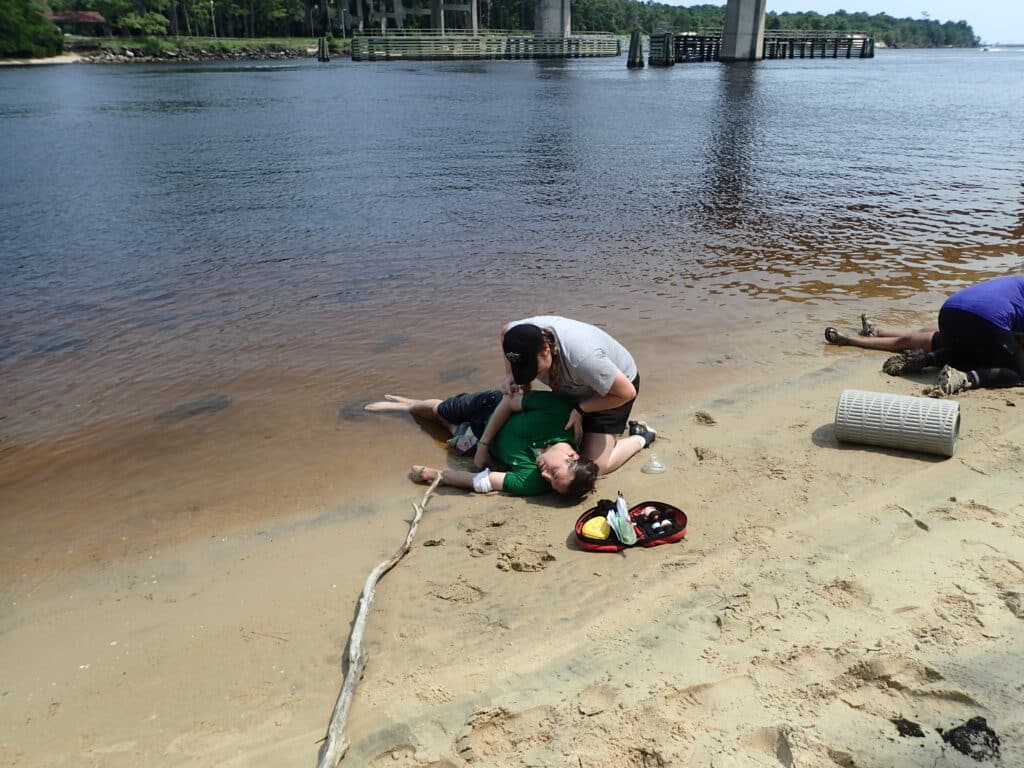
Of course, it’s during the spring and summer that most outdoor explorers are on the water, including those participating in backcountry expeditions. Lakes, rivers and streams provide much-needed relief in the backcountry on a hot August afternoon and are sought-after destinations for many outdoor enthusiasts.
For those training to become Wilderness First Responders (WFR) and those participating in Wilderness First Aid (WFA) training, a major consideration is assisting with medical emergencies that occur on or near the water. (more…)
Op-Ed: Has the Time Come to Standardize Wilderness Medicine Education and Training?
Wilderness Medicine TrainingThere is no shortage of wilderness medicine education providers in this country. From organizations that offer education and training for Wilderness First Responder (WFR) and Wilderness First Aid (WFA) certifications to those that offer train-the-trainer programs, a simple online search reveals a ton of options — especially when the search is focused on a specific geographical region.
What’s striking about all the wilderness medicine training and certification taking place is that none of it is nationally regulated. None of it adheres to commonly accepted industry standards that govern what’s being taught or how wilderness medicine education and training are being delivered. On the other hand, the training and certification EMTs receive is regulated on a state-by-state level and must meet minimum requirements as set by the National Highway Traffic Safety Administration (NHTSA).
Wilderness medicine training, while loosely adhering to a similar curriculum, is officially overseen by, well, no one. That being said, standardization and oversight aren’t completely absent. Several organizations have attempted to fill the void with a variety of education programs, courses, guidelines, accreditations, and oversight committees.
A Mismash in the Making
Historically speaking, first on the list is the Wilderness Medical Society (WMS) — a nonprofit founded in the early 1980s to encourage, foster, support, and conduct activities that improve the scientific knowledge of human health activities in a wilderness environment. WMS offers three types of advanced wilderness medicine-related certification that have a “continuing education” focus and accreditation connection. The organization’s Fellowship in the Academy of Wilderness Medicine (FAWM), Diploma in Mountain Medicine (DiMM), and Diploma in Diving and Marine Medicine (DiDMM) are all provided in accordance with standards set in part by the Accreditation Council for Continuing Medical Education (ACCME).
There’s also the fledgling Wilderness Medicine Education Collaborative (WMEC) — an ad hoc group of medical educators whose interest in providing guidance on content for wilderness medicine courses has resulted in the creation of minimum guidelines and scope of practice (SOP) documentation for Wilderness First Aid (WFA), Wilderness Advanced First Aid / Advanced Wilderness First Aid(WAFA/AWFA), and Wilderness First Responder (WFR) training. While the work of the collaborative (whose members include leaders from SOLO Wilderness Medicine, Wilderness Medical Associates International, and NOLS Wilderness Medicine, among others) has resulted in a robust set of SOPs, its influence is nonexistent outside those of us who actively choose to look beyond ourselves for best practices. In other words, without accreditation, there’s no real motivation for anyone offering wilderness medicine education to seek out the WMEC. And without a formal structure and an administrative arm, the WMEC has no enforceable authority or meaningful influence.
Speaking of accreditation, closer to home for those us in outdoor and experiential education, following a rapid increase in the number of adventure programs in the late 1980s and early 1990s, it became imperative that outdoor experiential education programs develop standards of program quality, professional behavior, and appropriate risk management. Enter the Association for Experiential Education (AEE), which responded to that need in the early 1990s by developing comprehensive standards for common practices in the adventure education industry, becoming the nation’s first recognized accreditation provider focused on outdoor and adventure-based experiential education programming.
(more…)Understanding the Role EpiPens Play in Urban and Wilderness Settings
Wilderness Medicine TrainingFor those who suffer severe allergic reactions to everything from wasp stings to wheat consumption, getting help — and getting that medical intervention fast — may mean the difference between life and death.
Here at The National Center for Outdoor & Adventure Education (NCOAE), we train our Emergency Medical Technician (EMT) students and Wilderness First Responder (WFR) students in the use of EpiPen, an autoinjector for those suffering a sudden anaphylaxis reaction.
This somewhat imposing emergency medicine tool is an injection device that contains epinephrine, a chemical that narrows blood vessels and opens airways in the lungs. A promptly administered injection may reverse severe low blood pressure, a rash or itchy skin, an alarming shortness of breath, hives, nausea, vomiting, and other symptoms of an allergic reaction.
Anaphylaxis is a life-threatening allergic reaction that requires immediate treatment, whether within the city limits or deep in the backcountry.
And while most anaphylaxis reactions are mild and self-limiting, it is impossible to predict — at least in the beginning — whether a reaction will become life-threatening. As a result, rapid intervention is always critical. A hiker’s risk for anaphylaxis increases if they suffer asthma that is severe or not controlled. Medical conditions such as heart disease can also increase the risk of an episode.
What can trigger an anaphylaxis episode?
The following are among of the most common causes of anaphylaxis:
- Milk, peanuts, tree nuts, eggs, shellfish, wheat, and soy
- Stings from bees, wasps, or fire ants
- Antibiotics, NSAIDs, or aspirin
- Latex
Adrenaline is the first line treatment for anaphylaxis and is most often administered using an autoinjector such as the EpiPen or drawn from a vial using a needle and syringe. EpiPen autoinjectors are available in two sizes — one for young children and another for those weighing more than 66 pounds. Since epinephrine is a prescription medication, anyone with a history of severe allergic reactions should have a prescription and the device at hand.
(more…)It’s a Good Week to Honor EMS Professionals
Wilderness Medicine Training“Adventure First, Education Always” is the rallying cry here at The National Center for Outdoor & Adventure Education’s (NCOAE). What you’ll find embedded in that statement is our commitment to students that they will return from our courses and trainings mentally, educationally and physically prepared for whatever brought them to us in the first place.
To that end, we offer a number of training courses that keep outdoor educators and backcountry guides up to date on the standard of care and best practices when managing medical emergencies in wilderness settings. In addition, we offer to the best of our knowledge the nation’s only 19-Day ‘Intensive’ EMT-Basic Training course.
EMT stands for Emergency Medical Technician — clinicians, trained to respond quickly to emergency situations regarding medical issues, traumatic injuries and accident scenes. Those clinicians tend to work with the EMS space, which of course stands for Emergency Medical Services.
People call EMS when they have had an accident or are experiencing a medical emergency, including heart attack, difficulty breathing, a fall or accident, drowning, cardiac arrest, stroke, drug overdose or acute illness. As a result, EMS professionals may have to provide basic and/or advanced medical care at the scene of an emergency and en route to a hospital.
Which brings us to the point of this blog post: (more…)
A Tip of Our Cap to the Wilderness Medical Society
Wilderness Medicine Training One thing we don’t do here at The National Center for Outdoor & Adventure Education is work within a vacuum. We depend heavily upon many organizations that went before us or that help us realize our mission and full potential.
One thing we don’t do here at The National Center for Outdoor & Adventure Education is work within a vacuum. We depend heavily upon many organizations that went before us or that help us realize our mission and full potential.
Today, we’d like to shine the light on one of those groups that works behind the scenes to ensure that our efforts in outdoor education, adventure travel and backcountry guiding continue to benefit from standards that keep us and our clients safe and sound in the wilderness.
Specifically, we’d like to tell you briefly about the Wilderness Medical Society (WMS), which was formed in 1983 by three California physicians — Drs. Paul Auerbach, Ed Geehr and Ken Kizer — who integrated the sound principles of medical practice within a wilderness setting.
The specific purpose of the Wilderness Medical Society was to encourage, foster, support, and conduct activities or programs concerned with life sciences, which may improve the scientific knowledge of the membership and the general public in matters related to wilderness environments and human activities in these environments.
As envisioned by these three physicians, WMS evolved into the world’s leading organization devoted to wilderness medical challenges. What challenges? These include wild animal attacks, wilderness trauma, expedition and disaster medicine, dive medicine, search and rescue, altitude illness, and weather-related illnesses.
This society explores health risks and (more…)
Wilderness Medicine Training in North Carolina
Wilderness Medicine Training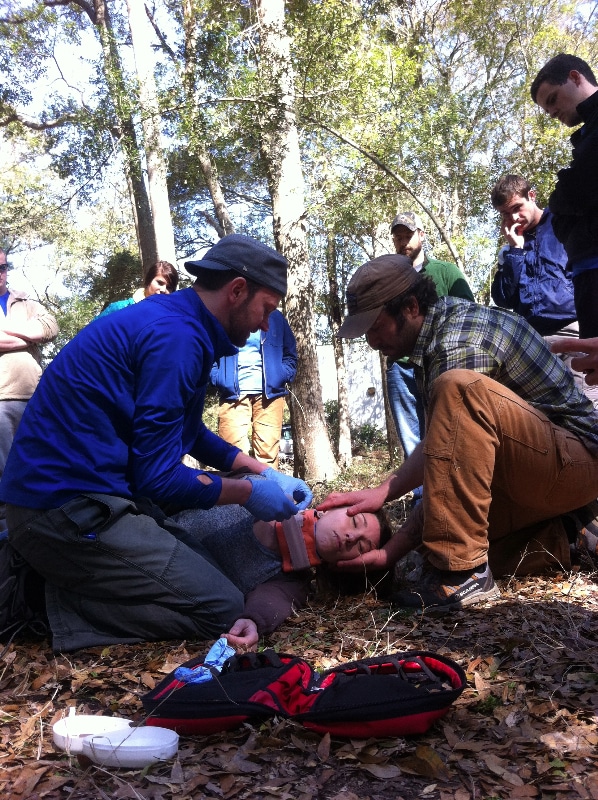 Working in remote settings has its challenges. From the lack of a quality connection to the Internet and having to find alternate ways to ‘go to the bathroom,’ to not being able to find a doctor precisely when you may need one, working remotely takes on all new meaning when you’re outdoor educator or backcountry wilderness guide. And while there’s nothing we can do for you here at the National Center for Outdoor & Adventure Education (NCOAE) about the Internet connectivity issue, we sure as heck can train and prepare you or your staff for medical emergencies that happen five or 500 miles away from the nearest hospital.
Working in remote settings has its challenges. From the lack of a quality connection to the Internet and having to find alternate ways to ‘go to the bathroom,’ to not being able to find a doctor precisely when you may need one, working remotely takes on all new meaning when you’re outdoor educator or backcountry wilderness guide. And while there’s nothing we can do for you here at the National Center for Outdoor & Adventure Education (NCOAE) about the Internet connectivity issue, we sure as heck can train and prepare you or your staff for medical emergencies that happen five or 500 miles away from the nearest hospital.
If you take a moment to really think about it, the practice of wilderness medicine has been around a lot longer than anyone really knows. We venture to say that its existence predates 1,800 BC, when the Code of Hammurabi first set out fees for surgeons and punishments for malpractice. Since the very first opportunity to provide lifesaving care in a remote setting, wilderness medicine has been a thing.
Of course, no one on the battlefields of Elam’s Invasion into Mesopotamia ever yelled for a ‘wilderness’ medic. Regardless, “the advancement of wilderness medicine has been closely connected to military exploration/operations throughout history, and not surprisingly, this remains in many ways as true today as it was a thousand years ago,” wrote George W. Rodway in a paper titled The Foundations of Wilderness Medicine: Some Historical Features.
Fast forward to 2015, and NCOAE — through its affiliation with the Wilderness Medicine Training Center — has emerged as a leading provider of wilderness medicine training in North Carolina (and as a custom training provider, anywhere in the world). More to the point, we’re the only provider to offer a Hybrid Wilderness First Responder (WFR) training and a Hybrid Wilderness First Aid (WFA) training, all under one roof. What’s this ‘hybrid’ thing we’re referring to? Good question. Read on, grasshopper.
For people interested in receiving training and certification in the administration of wilderness medicine but can’t get away from home or work for weeks at a time to participate in such trainings, hybrid training allows you to (more…)
Old School Tips for Handling Bleeds on the Trail Get a Needed Update
Wilderness Medicine TrainingInjuries that involve bleeding are not completely uncommon to those of us who visit or work in the backcountry. In fact, injuries that produce blood are considered inherent risks in wilderness travel, whether that be during a multi-week expedition or an afternoon hike in your local woods.
Knowing how to handle medical emergencies — and that includes knowing how to stop the bleeding when it occurs — is an essential backcountry skill. But here’s the thing… when it comes to bleeding, some “vintage” emergency tactics may have outlived their usefulness. For example, if you’re old enough to remember first aid courses where you were taught to use pressure points or to elevate the injured site, you should know this:
Those methods have been found to be ineffective and are no longer recommended.
So today, we’re going to talk about this commonly encountered medical problem, and how the vast majority of bleeding issues can be effectively and rapidly controlled by almost anyone with a few simple techniques. Fist though, let’s cover the three types of external bleeding.
Types of external bleeding
External bleeding is visible, whereas internal bleeding is not. Internal bleeding can result from a variety of problems ranging from traumatic injuries to illnesses. Stopping internal bleeding requires advanced techniques and often surgery. In other words, if you suspect internal bleeding, call for help.
External bleeding is divided into three types: (more…)
TALK TO US
Have any further questions about our courses, what you’ll learn, or what else to expect? Contact us, we’re here to help!
